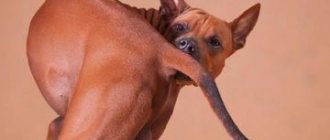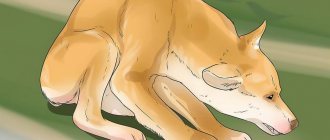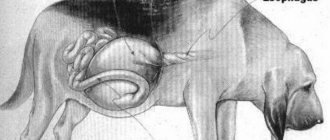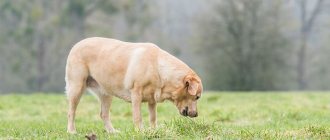Provoking factors
An increased interest in the dog's own tail, which suddenly appears in the dog, is a reason for a careful examination of this part of the body. Perhaps there are tufts of stray fur on it, or thorns have become attached to it during a walk. Skin diseases cannot be ruled out. If a visual inspection of the tail does not reveal any problems, you need to contact a veterinary hospital and find out the cause.
The dog may chase its tail due to itching in the anal area. This indicates the presence of worms. This symptom is observed if the paraanal gland is inflamed. It is difficult to make a correct diagnosis and choose an effective treatment; it is better to entrust the diagnosis and prescription of medications to a veterinarian. Specialists know how to cleanse the glands and will take samples. If necessary, a course of treatment will be prescribed. It is necessary to observe the prevention of helminths, give your pet special means twice a year. It is not easy to identify worms; tests take several days.
The reason for this behavior may be a not entirely successful tail docking operation. For some breeds, removing this entire body part or shortening it is a mandatory procedure. Injuries to adjacent tissues occur when an excessive amount of connective and muscle tissue is removed, leaving a fragment of the chain of bones formed by the spinal ridge. The presence of damage causes the pet to chase its tail. In this case, you need to contact a veterinary hospital. Only surgery can eliminate this problem.
What to do? First aid
In any case, carefully examine the dog. Does your companion have fleas? There may be bites, wounds or inflammation on the skin. One of the most dangerous misfortunes is Ustyug. These are green or yellow spikelets that cling to the fur and pierce the skin. “Grains” can migrate inside the body and cause suppuration. Additionally, examine the paraanal glands.
It is important to treat your dog for parasites on time. If the time has come, buy flea and helminth products. It makes sense to take a stool test. Protozoa may be found in it. In addition, gastrointestinal diseases, if any, will be detected. The veterinarian may order additional tests. For example, an x-ray if a fragment of bone tissue remains during tail docking.
What to do if the dog is completely healthy? Try to pay more attention to her. Train, socialize and play often. Do not encourage a bad habit: chasing your tail in any case should not turn into an obsessive movement.
Treatment for your pet depends on determining the cause. If you cannot cope on your own, it is better to consult a veterinarian. The measures you take may have the opposite effect. For example, an Elizabethan collar will only aggravate the situation if the dog has a mental disorder.
Monitor your dog's health, pay attention to changes in behavior and spend enough time with your companion. Then the pet will be happy next to you.
Injuries, psychological problems that provoke tail chasing
When receiving injuries that disrupt the functions of the nerve endings located on the hind limbs, the dog instinctively tucks its tail. In this case, inappropriate behavior is also observed.
If coordination problems occur during the race for the tail, you need to check the organs responsible for the position of the body and head. There may be a simultaneous deterioration in the pet's condition. He begins to vomit and has bowel movements. This indicates a malfunction of the liver or an increase in blood sugar. To a greater extent, such pathologies are characteristic of small breed dogs.
Often, owners think that if a dog starts chasing its tail, it means it is bored and wants to play. This option is also possible. It is not difficult to check whether such behavior is a sign of illness or a desire to have fun. To do this, you need to try playing with your pet. He will definitely take his mind off the chase and join in the fun. But if after this the inappropriate behavior appears again, the reason lies not in boredom, but in the presence of problems.
This phenomenon does not necessarily indicate health problems. The dog can thus talk about a lack of communication. We must not forget that a dog is a social animal and needs to be in contact with its owner. Violations of the rules of going to the toilet, playing with the owner's favorite things, etc. can be regarded as signs of protest and demands for attention. If such methods do not help, the dog may begin to chase its tail. He does not know how the owner will react to such behavior, but he is trying to at least attract attention to himself. If the pet understands that in this way it is possible to call the owner for contact, he will use it regularly. You need to understand whether tail chasing is leverage in order to properly respond to this behavior.
These manifestations may indicate increased anxiety. In such cases, chasing the tail may be accompanied by aggressiveness, defecation in inappropriate places, barking, howling, and damage to property. In such cases, the dog’s breathing quickens, the pupils dilate, the ears are laid back, and saliva is released profusely. The cause of increased anxiety can be various irritants. If a dog has experienced stress in a certain situation in his life, when he finds himself in it again, he begins to chase his tail in order to distract himself from negative emotions.
Loud noises can cause stress in a dog. This could be a crash from a fallen heavy object, music, a sharp alarm, etc. For some pets, stress appears when there is a knock, a doorbell ringing, a crying child, or barking dogs on the street. If your dog is hypersensitive to sounds, his behavior needs to be corrected. A dog is a member of the family and deserves appropriate attention.
A complex of symptoms, including chasing the tail, biting non-existent fleas, excessive licking, tearing out tufts of fur, aggression, and the desire to eat inedible objects, may be the first sign of neurosis, and not evidence of poor upbringing. Chaotic chasing your own tail may be a consequence of insufficient activity. This phenomenon is sometimes observed in dogs that are constantly kept in an enclosure.
Causes of tail chasing
It is difficult to immediately tell why a dog is trying to catch its tail. To make an accurate diagnosis, you need to observe your pet and analyze the situation. For example, if an animal tries to lick or chew out fur, something is probably bothering it. A possible cause is a sharp spikelet, a wound or stray hairs.
It is not always the tail that causes discomfort. Often, restless behavior is associated with inflammation of the anal glands. You can clean them yourself, but if you lack experience, it is better to contact a specialist. Itching can be caused by helminths. Sometimes a bad habit occurs after improper tail docking .
Presence of third-party symptoms:
- digestive disorders;
- general malaise;
- vomit.
Pathologies of the gastrointestinal tract (gastrointestinal tract) may be suspected. A dog may chase its tail when it has diarrhea. The culprits are itching and irritation.
Sometimes the cause lies in mental disorders. Dogs that want attention often chase their tails. They remember that their owners are happy, laugh and pet them, and then repeat the actions. Obsessive “chasing” may indicate increased levels of anxiety. In this case, running can be compared to the human habit of biting nails. Thus, pets try to get rid of accumulated stress.
It is important to evaluate the dog's behavior as a whole. Does she bark when you are not home? Is your pet prone to destruction? The answers to these questions will help you get closer to the truth.
What should be done to stop this behavior?
Having identified the reason, you can find out how to stop your dog from chasing its tail:
- Worms. Get tested at a clinic to find out the type of parasite and receive appropriate treatment. As a preventive measure, it is recommended to give anthelmintic drugs as prescribed by a doctor.
- Skin parasites. Carefully inspect the area of concern; if you find a tick, it is better to seek help from a specialist. It must be removed correctly - along with the head. In addition, it can cause an infection. Fleas are poisoned by chemicals and shampoos. For prevention, a special collar is worn.
- Inflammation of the paraanal glands. Contact your veterinarian immediately. He will tell you how to properly clean them at home.
- Skin diseases. They also require immediate consultation and treatment from a specialist.
- Allergic reaction. Eliminate allergens from your diet. It could be fish, dairy products or chicken. Carefully monitor your body's reaction to each new ingredient. Do not feed multiple species at the same time.
- Psychological reasons. Do not resort to physical punishment or lock your dog in a crate - this will only make the problem worse. Eliminate irritating factors. The source may be strangers, small children, or other pets. Walk your dog more often, engage in active games, and give more love and attention.
Behavior correction should preferably be carried out under the guidance of a specialist. It is important to establish a trusting relationship with the animal. Avoid tense situations. Distract your dog with a game if he starts circling. Do not show weakness and do not feel sorry for the dog.
Useful video on the topic: why does a dog run after its tail and bite it?
The dog bites its tail and draws blood! What does it mean?
If your pet bites its tail and at the same time squeals in pain, then the reason, of course, is not ordinary boredom! This may be a sign of a much more serious problem - a nervous disorder.
The reasons are often:
- separation stress
- extreme neglect of a dog
- lack of socialization
- separation of the puppy from the mother too early
- bad diet
- Breed: Some dogs are more susceptible to neurosis than others. The problem most often affects bull terriers and German shepherds.
Help from specialists
Contacting a veterinarian is necessary when the situation is not related to play. If your pet is very ill, it is better to bring him to the clinic by car. The doctor will conduct an examination, interview the owner and take tests, if necessary. Based on the data obtained, a diagnosis will be made and appropriate treatment will be prescribed.
Catcher's syndrome often becomes a problem for both the owner and the four-legged pet. You shouldn’t turn a blind eye to this, because in this way the pet can let you know that not everything is okay with it.
Why does a dog chase its tail?
Catching syndrome is what this phenomenon is called among veterinarians. If your dog is chasing his tail and biting it, there could be several reasons. It is worth taking a closer look at the animal. Perhaps a burdock or a piece of dirt simply stuck to this part of the body.
Veterinary reasons
Itching, burning and other physical discomfort in the tail area prompt the dog to solve this problem. A common cause is parasite infestation. Irritation in the anus causes the desire to scratch the disturbing area.
Signs of helminths:
- “rolling” on the floor on your butt;
- difficulty defecating;
- abdominal volume increases with general weight loss;
- body development lags behind breed age norms;
- bloody impurities appear in the stool.
Expert opinion
Kuzmenko Olga Olegovna
Information about the expert
Ask a Question
To protect the animal from parasites, it is necessary to regularly administer anthelmintic drugs. It is enough to carry out preventive maintenance twice a year.
► An allergic reaction can cause irritation in the anal area. Examine your skin carefully for signs of:
- decrease in wool quality;
- formation of bald spots;
- appearance of a rash.
Try replacing the food with a better quality one or choose rabbit instead of chicken. As soon as the itching on the skin subsides, the pet will forget about the stupid habit.
► Hormonal imbalances also cause discomfort in the anal area. The animal becomes irritable and embittered. A dog chases its tail during heat; adult castrated males experience the same problems. In this case, you need to contact a veterinarian. The doctor will select a course of treatment and everything will return to normal.
► Injuries cause severe anxiety for the pet. Carefully inspect the tail for wounds. Feel to rule out vertebral displacement or swelling.
If the puppy was recently docked, the doctor could have left the tip of the stump sharp, and it would injure the skin. Contact a specialist again to relieve your baby of pain.
► Vestibular syndrome is a serious disease that occurs as a result of head trauma, tumor formation, hormonal imbalance and inflammatory processes. The vestibular apparatus coordinates the body in space. When an imbalance occurs, the dog's behavior becomes strange.
Symptoms of the disorder:
- Hearing impairment.
- Eye twitching.
- The appearance of seizures.
- Incorrect head tilt.
- Random falls.
- Refusal to eat.
- Diarrhea, vomiting.
If treatment is not started, the consequences will be tragic. The dog will lose orientation in space, begin to fall, defecate on itself and eventually die.
► The appearance of fleas, ticks and other ectoparasites. Microscopic creatures that parasitize the animal’s body prefer areas of the skin that are more exposed to fur. They are also attracted to the sebaceous glands near the anus. It is difficult for the dog to reach them in this area.
If you do not get rid of ectoparasites in time, a disease called demodicosis may occur.
► Inflammation of the anal glands. The secret they produce allows them to mark their territory. They are located near the anus. When the canals become clogged, the glands become inflamed. The dog will try to reach its tail and “roll” on its butt.
► Skin diseases – eczema and dermatitis. Severe itching occurs in several areas of the body, including the anus.
Psychological reasons
Catch-tail syndrome is a genetic disorder caused by obsessive-compulsive disorder. Obsessive desires arise, which over time manifest themselves in the behavior of even a well-mannered dog.
At first this is expressed in close attention to the back of the body. The pet can growl and bark. The dog then chases its tail, trying to catch it with its teeth. The syndrome is diagnosed at an early age.
Signs of the disease:
- Biting off areas of fur.
- Increased irritability.
- Coprophagia – eating feces.
- Diligent licking of paws.
- Aggressive behavior.
The animal needs regular observation by a specialist. The disease cannot be cured, but the dog's behavior can be corrected. The individual is not used for breeding so as not to pass on diseased genes to offspring.
Pet playing
When all of the above reasons are excluded, all that remains is the version of pet pampering. Boredom and lack of active games make the dog want to entertain itself. Often in this way the animal tries to attract the attention of the owner. If the first attempt is successful, others will follow.
It happens that the hunting instinct manifests itself in this way in puppies. They catch all moving objects that come into their field of vision. But if you load the dog with enough activity, he will not look for additional entertainment.
If you do not stop such games from the beginning, they will smoothly turn into a habit. The owner should devote more time to the pet. Walk longer, train and praise for obedience.











